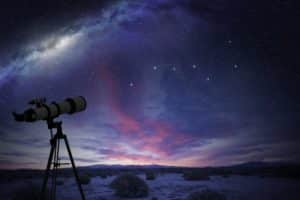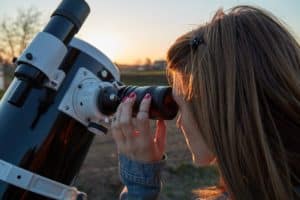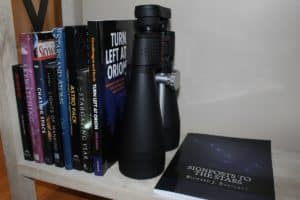Computerized telescopes come in a variety of shapes, sizes and price points. They can make excellent starting points for beginners and provide top-of-the-line practicality and enjoyment for more experienced amateur astronomers. They make it easy to find planets and deep sky objects, saving newbies the trouble of having to navigate the stars and helping even experienced observers find objects to view in areas with more light pollution and difficult viewing conditions. It’s truly amazing technology, making computerized telescopes some of our favorites at TelescopeGuide.org! Keep reading for our top 10 recommendations for best computerized telescope.
See also:
(Before we begin, please note that product pricing, price categories and availability are accurate as of the date of this post, but are subject to change. This post represents the author’s opinion, based on research and experience, of the “best” or “top” telescopes in this category; the opinions of others may vary.)
Basic Types of Computerized Telescopes
People looking for the best computerized telescope are typically looking for a refractor, reflector or Dobsonian telescope with “GoTo” technology for an automated mount. However, there are actually a number of different flavors or sub-types of computerized telescopes to consider. Each has its place, appealing to different types of users, needs, and budgets.
1. Fully Automated (“Go-To”) Telescopes
With a fully automated GoTo telescope, the mount and related software enable the telescope to find targets completely on its own. You simply tell it what you want to see, and the mount takes care of the rest. The best computerized telescopes can even align themselves and give you a tour of the night sky, referencing a database of thousands of objects visible from your specific location. Celestron’s “NexStar” series of telescopes are great examples of this type.
Alt-Azimuth Style GoTo Telescopes
Many of the most popular computerized telescopes on the market leverage an Alt-Az mount. Why? Well… 3 reasons. First, computerized Alt-Azimuth mounts are less expensive compared to Equatorial mounts with similar technology. Second, Alt-Az mounts are lighter and more compact, allowing the telescope to be much easier to work with for setup and portability. Third, computerized Alt-Az mounts (unlike manual Alt-Az mounts) do a great job tracking objects across the sky – so the average user has less need for an equatorial mount.
Equatorial Mounted GoTo Telescopes
If you’re serious about astrophotography, then you know the importance of being able to take long-exposure images. The best astrophotography shots often require hours of total exposure time, while the telescope remains perfectly trained on your target. For this kind of precision tracking, nothing beats the smoothness and accuracy of a fully computerized equatorial mount.
However, equatorial GoTo mounts are typically more expensive, more challenging to use, and larger/heavier compared to their Alt-Az counterparts. They also tend to be a little more specialized, leveraging a separate “guide scope” allowing the mount’s auto-guiding capability.
While we are including a couple of telescopes in this article that come bundled with a GoTo equatorial mount, you should be aware that the majority of GoTo equatorial mounts are sold separately from the telescope’s optical tube. For more options beyond this article, check out our article on mounts for astrophotography.
2. Computer-Assisted (“Push-To”) Telescopes
The telescope is equipped with sensors and a computerized database capable of directing the user to their desired target in the sky. However, computer-assisted telescopes are not fully automated – you still have to move the telescope yourself as the computer guides you to your target. Orion’s “IntelliScope” products are good examples of this type.
Our Take on the Best Computerized Telescopes
1. Celestron NexStar 8SE Computerized Telescope – Our Top All-Around Choice
Our #1 pick for the best computerized telescope is the Celestron NexStar 8SE (full review here) – an all-around versatile, high quality choice no matter your experience level. Celeston’s NexStar SE line is one of the most popular computerized telescopes, and the NexStar 8SE serves as the flagship.
Scorecard – Celestron NexStar 8SE Computerized Telescope
| Category | Our Verdict | Why? |
|---|---|---|
| Skill Level | Beginner to Intermediate | Advanced computerized capabilities make it easier to operate |
| Quality | 5 out of 5 | Great warranty and solid component quality |
| Ease of Use | 5 out of 5 | Automatically locates and tracks objects |
| Power & Clarity | 5 out of 5 | 8" aperture ideal for beginner to intermediate experience |
| Control | 5 out of 5 | Computerized AZ mount |
| Portability | 4 out of 5 | Great portability but not ideal for hiking |
| Accessories | 3 out of 5 | Basics included but there are a few additional things you'll probably want to add |
| Overall Value | 5 out of 5 | Flagship of the excellent NexStar SE line |
Why We Like It
The NexStar 8SE excels in a number of areas. First, its 8″ Schmidt-Cassegrain optical design with StarBright XLT optical coating provides excellent performance. You can really enjoy bright, detailed images with this scope. Second, the computerized mount quickly orientates itself with SkyAlign technology and can automatically find 40,000 astronomical objects selected by a handheld remote. Third, Celestron’s NexStar 8SE sets up and breaks down quick, so you’re more likely to use it. Fourth, at 33 lbs, it can also be ported around without much trouble.
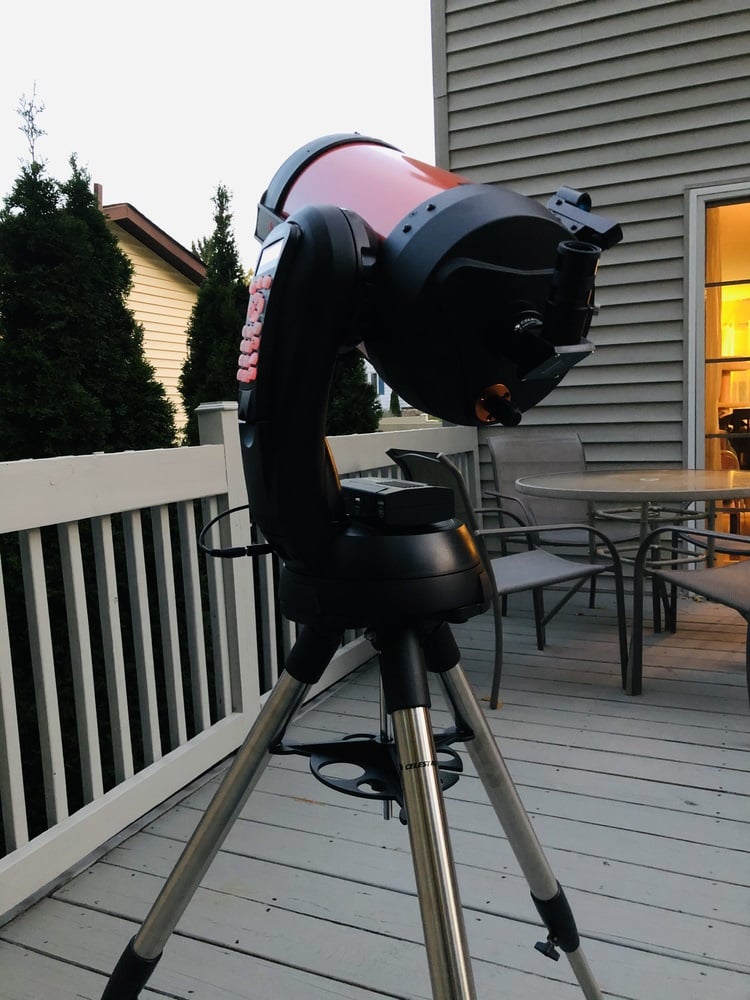
Image Credit: S. D. Falchetti (Used with Permission)
The great optics, computerized features, ease-of-use and relative portability make the NexStar 8SE one of the best all-around Celestron telescopes in our view. (In fact, we’re big fans of the entire Celestron NexStar SE family, and this #1 ranking is our vote of confidence in the SE product line.)
It offers excellent value from a reliable brand backed by a 2-year warranty. The telescope weighs in light enough to transport to your favorite site (though not for hiking). It provides great images from its 2032mm focal length and 203.2mm aperture. With the right accessories, the NexStar 8SE can also serve as a solid option for short-exposure astrophotography.
Celestron has built a truly high-quality, all-around winner with the NexStar 8SE that will keep you engaged with stargazing for many years.
Pros
- Superb value for money in our opinion
- User-friendly design, fully computerized “GoTo” capability making it easy to track and find objects
- Simple setup; great portability for the price point
- Quality construction
- 2-year Celestron warranty
- Great visuals, capable of beginner (short-exposure) astrophotography
Cons
- We wish it came with more eyepiece options and GPS
Recommended Accessories
Click here to expand- If you want to connect your DSLR camera (Canon or Nikon), Celestron sells the appropriate T-adapter and T-rings here: See it on Amazon.com
- Carrying case for NexStar optical tubes: See it on Amazon.com
- Eyepieces: See it on Amazon.com
- Power tank: See it on Amazon.com
2. Orion StarSeeker IV 130mm GoTo Reflector Telescope Kit – Our Best Value Choice

Image Credit: Orion (Used with Permission)
The Orion StarSeeker IV 130mm GoTo Reflector Telescope packs a ton of value into this starter telescope kit. It’s another excellent telescope from Orion for beginner-to-intermediate amateur astronomers. The StarSeeker IV features an f/5 focal ratio on a moderate 650mm focal length that allows it to collect a lot of light. As a result, it can produce some stunningly bright, widefield views of the night sky.
The Orion StarSeeker IV Kit package also comes with an amazing set of accessories. You’ll get an altazimuth mount, a tripod, accessory tray, Orion AZ/EQ Computerized GoTo Hand Controller (Synscan), a 10mm and 23mm wide-field 60° AFOV eyepiece, shorty 2x Barlow lens, moon filter, 12V DC power cable, AC-to-DC adapter, Orion’s MoonMap 260 and DeepMap 600, as well as other items. We are always impressed with the value Orion packs into these kits, and the StarSeeker IV is no exception.
Additionally, the computerized, GoTo features of the Orion StarSeeker IV can guide you to over 42,000 objects that include stars, double stars, galaxies, nebulas and star clusters. You can even set the telescope in “tour” mode to guide you through what’s visible on a particular clear night.
Finally, the StarSeeker IV tyically comes at a lower price than most other selections on our list, making this our best value pick. The bright, wide viewing and jam-packed accessories make this a hard telescope to pass up.
Scorecard – Orion StarSeeker IV Telescope Kit
| Category | Our Verdict | Why? |
|---|---|---|
| Skill Level | Beginner | Computerized capabilities |
| Quality | 4 out of 5 | Good component quality |
| Ease of Use | 5 out of 5 | Automatically locates and tracks objects |
| Power & Clarity | 4 out of 5 | Good aperture; bright, wide views |
| Control | 4 out of 5 | Computerized mount with Go-To capability |
| Portability | 3 out of 5 | At 21lbs, not the most portable |
| Accessories | 5 out of 5 | Superb set of accessories |
| Overall Value | 4 out of 5 | Exceptional value pack |
Why We Like It
The StarSeeker IV takes the crown for our best value pick. It provides an excellent set of accessories and options – everything a beginner astronomer might want to get up and running – along with stellar image quality for bright, wide views and solid construction from a trusted name.
Pros
- Amazing accessory set
- Bright, wide views
- Great GoTo functionality
Cons
- At 21lbs, less portable than some options
3. Celestron CPC 1100 StarBright XLT GPS Telescope – Our Top Enthusiast Choice
The CPC 1100 offers next-level deep sky images and planetary viewing, making it one of the best computerized telescopes. It’s an excellent option for intermediate amateur astronomers looking for stunning visuals combined with goto capability.
A few CPC 1100 features really stand out. Most importantly is its superb images. The sizeable 11” Schmidt-Cassegrain optical tube with StarBright XLT optical coating provides amazingly sharp, bright views. Celestron has also put considerable effort into crafting a solidly-built instrument with good ergonomics.
Additionally, the computerized altazimuth mount allows for good tracking accuracy, and the SkyAlign and GPS technologies make the CPC 1100 exceptionally easy to orientate. (The GPS means you don’t need to enter the date or location coordinates by hand.)
Finally, the CPC database and go-to functionality simplifies the process of finding over 40,000 celestial objects (including Messier objects, galaxies, nebulae and planets) for a highly enjoyable user experience.
Overall, the stunning views, solid construction, ease of use and strong support make the CPC 1100 a worthwhile investment that you can enjoy for decades.
Scorecard – Celestron CPC 1100 StarBright XLT GPS Telescope
| Category | Our Verdict | Why? |
|---|---|---|
| Skill Level | Intermediate | Excellent images, but not the cheapest model |
| Quality | 5 out of 5 | Great warranty and solid component quality |
| Ease of Use | 5 out of 5 | GPS, SkyAlign and automated object location |
| Power & Clarity | 5 out of 5 | 11" aperture provides excellent images |
| Control | 5 out of 5 | Computerized AZ mount and remote |
| Portability | 1 out of 5 | Sturdy but heavy |
| Accessories | 3 out of 5 | Basics included; sturdy mount |
| Overall Value | 5 out of 5 | Excellent overall, but not portable or priced for beginners |
Why We Like It
The CPC 1100 is, in our view, one of the best computerized telescopes for astro-images and overall enjoyment. We strongly recommend a deep dive into this one.
Celestron went back to the drawing board with the CPC line of telescopes. The results were a top-rated product that offers simple alignment, functional GPS, unsurpassed optical quality, easy set-up, thoughtful ergonomics and enhanced computerization.
The construction quality is top notch, and the views can be breathtaking. The solid dual fork-arm mount and tripod also provide a very sturdy base for what is one of the heavier telescopes on our site (over 90 lbs including mount).
Pros
- Excellent viewing experience
- Fully-computerized operating system with GPS
- Sturdy, ergonomic design
Cons
- Heavy; not portable
Recommended Accessories
Click here to expandYou may want to pick up a Celestron power tank with your CPC 1100: See it on Amazon.com
4. Celestron NexStar 127SLT Computerized Telescope – Beginner Option A
Our top pick for the best computerized telescope for beginners is the Celestron NexStar 127SLT (very similar to the 130 SLT below), a Maksutov-Cassegrain telescope with computerized Star Locating Technology (i.e. “SLT”). Like others on this list, the 127SLT includes a database of more than 40,000 stars, galaxies and nebulae, which it can automatically locate for you after orientating itself based your location. You can use the hand-held control to choose specific objects that you would like to see, or have the telescope take you on a tour of the night sky. This is an amazing telescope for a great price that’s perfect for viewing from cities or suburban areas. It provides a durable, easy-to-use telescope for beginners and intermediate users alike.
Scorecard – Celestron NexStar 127SLT Computerized Telescope
| Category | Our Verdict | Why? |
|---|---|---|
| Skill Level | Beginner to Intermediate | Advanced computerized capabilities |
| Quality | 5 out of 5 | Great component quality |
| Ease of Use | 5 out of 5 | Automatically locates and tracks objects |
| Power & Clarity | 4 out of 5 | Good aperture, good magnification |
| Control | 5 out of 5 | Computerized mount; Star Locator tech. |
| Portability | 4 out of 5 | Light-weight and easy to move |
| Accessories | 3 out of 5 | Basics included but there are a few additional things you'll probably want to add |
| Overall Value | 4 out of 5 | Great value; great first telescope |
Why We Like It
The NexStar 127SLT is a fantastic telescope that, in our view, provides good value from a reliable brand backed by a 2-year warranty. At 18 lbs, the telescope is very portable. The controls and SLT automation make it extremely easy to use (alignment can be easily done via GPS coordinates). The 127SLT also provides great images at the price point with its 60x and 167x magnification, 127mm aperture and 1500mm focal length. The field of view is narrower than the 130SLT version below, but the telescope provides great planetary views and is appropriately sized for its mount.
Pros
- Extremely easy to track and find objects
- Simple setup; great portability
- Good visuals within a narrow field
Cons
- Best used with power tank or cable
Recommended Accessories
Click here to expandYou may want to pick up a Celestron power tank with your NexStar 127SLT: See it on Amazon.com
5. Orion 27191 StarBlast 6i IntelliScope Reflector Telescope – Our Top “Push-To” Tabletop Dobsonian Choice

Image Credit: Orion (Used with Permission)
Looking for a tabletop scope to avoid hassles with a mount? The Orion 27191 StarBlast 6i Intelliscope represents, in our view, one of the best computerized telescopes with a tabletop form factor. The Orion 27191 provides a computerized, “push-to” experience, helping beginner-to-intermediate astronomer easily locate deep sky objects. With its sizeable 150mm aperture, 750mm focal length and 21x magnification, you can enjoy sharp, contrast-rich views of brighter nebulae, galaxies, and star clusters, as well as planets, including Jupiter’s cloud bands. The Orion 27191 is easy to use right out of the box, and weighing 23.5 lbs, definitely transportable (if not a scope you want for general portability).
Scorecard – Orion 27191 StarBlast 6i IntelliScope Telescope Reflector Telescope
| Category | Our Verdict | Why? |
|---|---|---|
| Skill Level | Beginner to Intermediate | IntelliScope "push-to" capability helps you locate objects in the sky |
| Quality | 4 out of 5 | Sturdy component quality |
| Ease of Use | 4 out of 5 | Easy to use tabletop design; requires collimation |
| Power & Clarity | 4 out of 5 | Bright images with 6" primary mirror |
| Control | 4 out of 5 | Easy to point and move; requires manual tracking of objects with AZ mount |
| Portability | 4 out of 5 | Super compact and easy to setup for a 6" telescope |
| Accessories | 4 out of 5 | Good accessories from Orion |
| Overall Value | 4 out of 5 | Great value for tabletop design with computerized capability |
Why We Like It
The Orion 27191 is a sturdy, easy-to-use tabletop computerized telescope with “push-to” capability that makes it an excellent option for at home viewing. The images are great, and the Orion 27191’s optics really excel at wide field, larger object viewing. Finding deep sky objects can be difficult, and that’s where the go-to capability of this and other computerized scopes really comes in handy. It would be useful to combine this telescope with a Barlow lens for a bit more zoom capability. For someone looking to avoid hassles with tripods and mounts, while also getting excellent images, this is a way to go. Additionally, Orion always (in our experience) includes quality accessories with their scopes, and this is no exception. The Orion 27191 comes with two Sirius Plossl 1.25″ eyepieces (25mm & 10mm ), an EZ Finder II aiming device, eyepiece rack and Starry Night software.
Pros
- Easy to find objects using computerized “push-to” capability and Starry Night software
- Straightforward setup with tabletop form factor
- Good visuals for a wider field of view
- Sturdy base and design
Cons
- As a tabletop, less portable than some telescopes
- Best combined with a Barlow lens for more zoom capability
Recommended Accessories
Click here to expandWe would recommend purchasing a 2x Barlow lens with the Orion 27191: See it on Amazon.com
6. Celestron NexStar 130SLT Computerized Telescope – Beginner Option B
Another one of our top picks for the best computerized telescope (very similar to the 127 SLT above), the Celestron NexStar 130SLT offers a very portable, Newtonian Reflector with the same great SLT option as the NexStar127SLT above. The 130SLT provides a wider field of view compared with the 127SLT, and would be preferable if you were viewing large clusters and nebulae under a very dark sky. The optics permit you to see Saturn’s rings, Jupiter’s cloud bands, the Moon, & brighter deep sky objects.
The NexStar 130SLT also includes a database of more than 40,000 stars, galaxies and nebulae, which it can automatically locate for you after orientating itself based your location – much like other Celestron go-to telescopes. You can use the hand-held control to choose specific objects that you would like to see, or have the telescope take you on a tour of the night sky.
In sum, the Nexstar 130SLT is a great option if you’re looking for a “go-to” telescope with a wider field of view than the 127SLT.
Scorecard – Celestron NexStar 130SLT Computerized Telescope
| Category | Our Verdict | Why? |
|---|---|---|
| Skill Level | Beginner to Intermediate | Advanced computerized capabilities |
| Quality | 5 out of 5 | Great component quality |
| Ease of Use | 5 out of 5 | Automatically locates and tracks objects |
| Power & Clarity | 4 out of 5 | Good aperture, good magnification |
| Control | 4 out of 5 | Computerized mount; Star Locator tech. Scope can be a bit much for the mount. |
| Portability | 4 out of 5 | Light-weight and easy to move |
| Accessories | 3 out of 5 | Basics included but there are a few additional things you'll probably want to add |
| Overall Value | 4 out of 5 | Great value in a go-to scope |
Why We Like It
Firstly, like the Nexstar 127SLT above, the NexStar 130SLT provides good value from a reliable brand that offers a 2-year warranty. Secondly, at 18 lbs, the telescope is definitely portable, and like the 127SLT, the controls and automation of the 130SLT make it extremely easy to use (alignment can be easily done via GPS coordinates). Thirdly, while the telescope can be a bit much for the mount, the 130SLT provides great images at the price point with its 130mm aperture, 650mm focal length, and 26x and 72x magnification.
Pros
- Extremely easy to find objects due to SLT
- Simple setup; great portability
- Good visuals with a wider field of view than the NexStar 127SLT
- 2-year Celestron warranty
Cons
- Best used with power tank or cable
- A bit oversized for the mount
7. Celestron Advanced VX 6″ Schmidt-Cassegrain Telescope – Beginner Option for Astrophotography (Equatorial Mount)
Starter telescope for beginner astrophotography that includes Celestron’s Advanced VX computerized equatorial mount. This is a good option if you’re looking for a mount plus telescope in one package for beginner astrophotography. Celestron’s Advanced VX mount with 6″ Schmidt-Cassegrain (compound / catadioptric) telescope is suitable for long-exposure imaging while it also delivers a great experience for visual astronomy.
Scorecard – Celestron Advanced VX 6″ Schmidt-Cassegrain Telescope
| Category | Our Verdict | Why? |
|---|---|---|
| Skill Level | Beginner to Intermediate | Great option for beginner astrophotography |
| Quality | 4 out of 5 | Excellent overall quality |
| Ease of Use | 4 out of 5 | Great set of user-experience features with AVX mount |
| Power & Clarity | 4 out of 5 | Sharp imaging capability and 6" aperture |
| Control | 5 out of 5 | Computerized mount with autoguider port |
| Portability | 4 out of 5 | Telescope is compact and just 10 lbs. AVX mount is more portable than heavier options. |
| Accessories | 3 out of 5 | Just the basics and one 25mm eyepiece |
| Overall Value | 4 out of 5 | Excellent overall value |
Why We Like It
What’s great about this telescope from Celestron is that it includes two flagship components in one package. First, you get Celestron’s Advanced VX mount. It’s a fully computerized equatorial mount and includes an autoguider port for long-exposure imaging. The Advanced VX is still considered an entry-level mount for astrophotography, but it’s a huge step up from beginner telescope mounts. As long as your payload stays below 30 lbs., this mount provides a portable, light-weight option for high quality astro-imaging. (And that’s easy because the telescope tube only weighs 10 lbs. So you can still add a camera, autoguider, etc.)
Second, the telescope itself is a 6″ Schmidt-Cassegrain design which is a pretty good telescope for both imaging and visual astronomy. It’s compact and highly portable due to its compound design. The quality is excellent with StarBright XLT optical coatings. Further, image quality is crisp and sharp, and the Schmidt-Cassegrain design eliminates chromatic aberration.
You might notice the telescope advertises a focal ratio of f/10 – and that might seem at first like it’s too high for good imaging. However, you actually have 3 options: (1) You can use the f/10 ratio as-is. (2) You can add an optional focal reducer and get the ratio to f/6.3. And (3) you can use a 3rd party lens assembly to get a f/2 ratio.
Accessories are pretty basic. It comes with a 25mm eyepiece, 1.25” star diagonal and 6×30 finder scope.
Pros
- Great for visual astronomy and beginner astrophotography
- Delivers sharp images
- Compact & portable (if not super lightweight at 28 lbs.)
- 2 year warranty from Celestron
Cons
- Only one eyepiece included
Recommended Accessories
Click here to expand- Celestron focal reducer designed specifically for this telescope, gives you a f/6.3 ratio: See it on Amazon.com
- PowerTank portable power supply: See it on Amazon.com
- DSLR camera T-adapter and T-rings: See it on Amazon.com
- Celestron carrying case compatible with this optical tube assembly: See it on Amazon.com
8. Celestron NexStar 102SLT Computerized Telescope – Refractor Option A (Mid-Range Budget)
Our pick for best mid-range computerized refractor. If you’re looking for a computerized refracting telescope, the Celestron NexStar 102SLT offers excellent quality and a nice blend of features in a user-friendly package. The computerized system makes it incredibly easy to use (so you can spend more time viewing vs. trying to find things in the night sky), plus it offers bright & clear images with its huge 102mm refracting lens. Additionally, it’s highly portable and lightweight, so you can easily bring it with you into the field.
Scorecard – Celestron NexStar 102SLT Computerized Telescope
| Category | Our Verdict | Why? |
|---|---|---|
| Skill Level | Intermediate | Advanced computerized capabilities |
| Quality | 4 out of 5 | Great component quality |
| Ease of Use | 5 out of 5 | Automatically locates and tracks objects |
| Power & Clarity | 4 out of 5 | Wide aperture, somewhat low magnification w/ included eyepieces, some chromatic aberration |
| Control | 4 out of 5 | Computerized AZ mount |
| Portability | 4 out of 5 | Light-weight and easy to move |
| Accessories | 3 out of 5 | Basics included but there are a few additional things you'll probably want to add |
| Overall Value | 4 out of 5 | Great value |
Why We Like It
The flagship selling feature here is the drop-dead simplicity of the computerized “star locating technology” (SLT for short) alt-azimuth goto mount. It has a database of 40,000 stars, galaxies, nebulae, and more. With its “sky tour” feature it can automatically recommend and locate the best objects based on your precise time and location – and then it can automatically track the objects across the night sky. It also comes with a “SkyAlign” technology that makes it easy to setup and use. Once you’ve gone through the alignment procedure by locating 3 bright objects in the sky, you’re all set and ready to go.
With a powerful 102mm aperture, The NexStar 102SLT also offers clear & bright images in a super-easy-to-use package. As with any refractor, there is the possibility of chromatic aberration, but you can lessen the impact of that with a Baader fringe killer filter.
In terms of accessories, the telescope comes with all the basics you need, including a red dot StarPointer finder scope, two eyepieces (25mm and 9mm, for 26x and 73x magnification, respectively), and an adjustable full-height steel tripod, plus an accessory tray. That’s not a lot of magnification out of the box, so you may want to add additional eyepieces. Celestron also recommends a few specific upgrades: StarSense Auto Align, and SkyPortal Wi-fi Module.
Pros
- Sophisticated computerized AZ goto mount can recommend, locate, and track 40,000 celestial objects – automatically!
- Powerful aperture for bright and clear images
- Portability is pretty good at 14 lbs. assembled weight
- 2 year warranty and great support from Celestron
Cons
- Chromatic aberration is possible (can be reduced with use of a Baader fringe killer filter)
- The included eyepieces limit your max magnification to 73x – so you may want to upgrade the eyepieces
Recommended Accessories
Click here to expand- Celestron PowerTank for computerized telescopes:
- Baader fringe killer filter:
9. Celestron Advanced VX 6″ f/8 Refractor Telescope – Refractor Option B (Higher Budget, Equatorial Mount)
Our pick for best computerized refractor telescope – boasting high-end magnification and a huge 150mm aperture. The Celestron Advanced VX 6″ f/8 refractor telescope is an amazing piece of equipment providing incredible brightness and magnification capability, plus a fully computerized German equatorial goto mount. It provides features comparable to much more expensive equatorial mount telescopes. If you’re looking for raw power combined with a sophisticated computerized goto mount, this could be the perfect refractor for you.
Scorecard – Celestron Advanced VX 6″ f/8 Refractor Telescope
| Category | Our Verdict | Why? |
|---|---|---|
| Skill Level | Advanced | For advanced users |
| Quality | 5 out of 5 | High-end computerized mount and excellent overall quality |
| Ease of Use | 4 out of 5 | Great set of user-experience features; but not for beginners |
| Power & Clarity | 5 out of 5 | Bright, clear, powerful magnification |
| Control | 5 out of 5 | Computerized mount with tracking capability |
| Portability | 2 out of 5 | Heavy but can still transport in a car |
| Accessories | 4 out of 5 | High-quality accessories |
| Overall Value | 5 out of 5 | Great value |
Why We Like It
This Advanced VX refracting telescope from Celestron offers two things that really set it apart. First, its computerized German equatorial mount is the most portable and compact of Celestron’s higher-end equatorial mounts. The mount offers a killer lineup of features for amateur astronomers – including All-Star Polar Alignment, Celestron PWI telescope control software, SkyAlign capability, and permanently programmable periodic error correction (PPEC). You’ll be able to find 40,000 objects in the night sky with ease, and the telescope automatically tracks objects as they drift across the sky due to the rotation of the earth.
Second, with its 150mm achromatic objective lens and focal length of 1200mm, this telescope offers bright, clear, and powerful magnification. The lens provides an absolutely massive level of light collection (125% more than a 100mm refracting lens) – which is perfect for high-contrast planetary viewing.
Note: While all achromatic refracting telescopes have the potential to experience some chromatic aberration (color distortion), this particular lens has been reported by users to provide excellent color accuracy and it seems to do a good job minimizing blue fringe. (Note: If you do experience this, you could consider filters such as the Baader Fringe Killer.) This is perhaps the only disadvantage to opting for such a large refractor – but keep in mind, this is also what makes this telescope affordable. (A 150mm APO lens would be immensely more expensive!)
You’ll find all the expected accessories included: 20mm eyepiece, 1.25” star diagonal, 9×50 finder scope, and a sturdy tripod with 2” diameter steel tripod legs. Overall, if there is room in your budget for this telescope, you won’t be disappointed!
Pros
- Massive 150mm aperture with powerful magnification capability
- Computerized German equatorial mount comparable to much higher priced telescopes from Celestron
- 2 year warranty, with unlimited access to Celestron’s team of US-based experts
Cons
- It’s pretty heavy (78 lbs. fully assembled) – but the tripod & mount are more compact and portable than other high-end computerized equatorials
- Some possibility of color aberration (which can be corrected with an additional filter accessory)
Recommended Accessories
Click here to expand- Baader fringe killer filter:
10. Meade Instruments StarNavigator NG 102mm Aperture Computerized GoTo Refracting Telescope
Beginner to intermediate user looking for your first computerized telescope? The StarNavigator NG 102mm GoTo Refractor provides a fantastic starting point to jump into stargazing or even astrophotography. The Meade Instruments telescope offers a unique, super cool feature in the AudioStar Hand Controller that can give up to 4 hours of audio descriptions of celestial objects, while automatically taking you on a tour of each one.
The StarNavigator features a102mm aperture and 660mm focal length for increased visibility and enjoyment. Additionally, it comes with a full-sized aluminum tripod, 2 x 1.25 MA eyepieces (9mm and 26mm), red-dot viewfinder, and level compass, as well as a vixen-style dovetail receiver to allow a mix of optical tube assemblies. The optical tube weights about 5lbs, and the entire set between 10-15lbs, which with the easy breakdown / dissassembly makes for decent portability.
Scorecard – StarNavigator NG 102mm GoTo Refracting Telescope
| Category | Our Verdict | Why? |
|---|---|---|
| Skill Level | Beginnger-to-Intermediate | Good functionality / ease-of-use, with solid build quality |
| Quality | 5 out of 5 | Solid component quality in 5lb optical tube |
| Ease of Use | 5 out of 5 | Unique AudioStar Hand Contoller |
| Power & Clarity | 3 out of 5 | Good images, subject to chromatic aberration |
| Control | 5 out of 5 | GoTo functionality |
| Portability | 4 out of 5 | Definitely portable at 10-15lbs |
| Accessories | 3 out of 5 | Decent mount and other accessories |
| Overall Value | 4 out of 5 | Excellent overall, but not portable or priced for beginners |
Why We Like It
The StarNavigator NG 102mm GoTo Refracting Telescope is one of the best computerized telescopes for beginners and intermediate users for a few reasons. Firstly, it scores particularly well in ease-of-use due to the AudioStar Hand Controller. Secondly, the construction quality / durability is high, as with all Meade Instruments products. The tripod mount isn’t the best for heavy-duty photography equipment, but works solidly enough for those just getting in on astrophotography and for other casual uses. Thirdly, the images are also clear and bright, though it will experience chromatic aberrations.
Pros
- AudioStar and GoTo Features
- Durability / build quality from well known brand
- Portability
Cons
- Tripod could be steadier
Honorable Mention: Orion StarBlast 114mm AutoTracker Reflector Telescope
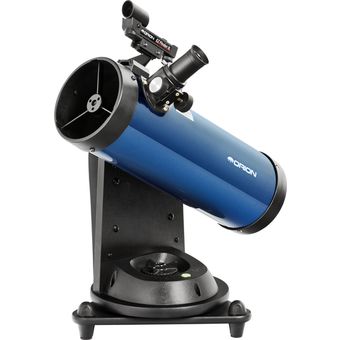
Image Credit: Orion (Used with Permission)
For an ultra-affordable motorized (but not quite computerized) telescope option, check out this tabletop reflector from Orion. It features Orion’s award-winning “AutoTracker” mount. Once you’ve aimed the telescope where you want to look, the mount will automatically track your target as it drifts across the sky.
Final Thoughts | Best Computerized Telescope
As you can see from this article, there are numerous options for computerized telescopes at a variety of price points.
If you’re primarily interested in visual astronomy and looking for the ease and convenience of a fully automated experience, then you’ll be best served by one of the GoTo Alt-Az options that suits your budget and your preference between reflectors and refractors. For astrophotography, an equatorial-based system will give you the best results.
Regardless of what you’re looking for, we hope this article gave you some great ideas to get started.
(Also, if you liked this article, please share it using the social media buttons below!)
Feature Image Credit: Allexxandar / iStock











